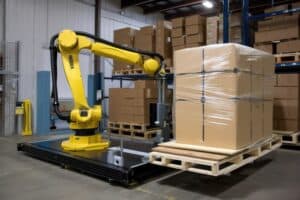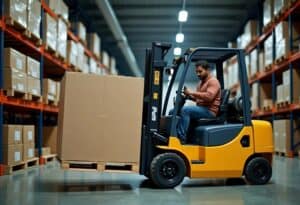Palletizing: The Key to a Streamlined Warehouse Operation
Efficiency is the name of the game in high-volume warehouses and fulfillment centers. Automated technology is commonplace, helping companies improve their material handling process and cut costs throughout their supply chain. Palletizing technology has proven to be an invaluable resource in most facilities. It’s versatile, adaptable, and helps streamline warehouse operations from goods receipt to shipping.
 Innovations in logistics automation have spread to almost every industry. From automotive parts to food, companies can now find automated palletizing systems that suit their product lines and business goals. Artificial intelligence, machine learning, robotics, and conveyor technology give palletizer systems the power to transform any end-to-end warehouse operation.
Innovations in logistics automation have spread to almost every industry. From automotive parts to food, companies can now find automated palletizing systems that suit their product lines and business goals. Artificial intelligence, machine learning, robotics, and conveyor technology give palletizer systems the power to transform any end-to-end warehouse operation.
Let’s take a closer look at how these innovative tools make material handling easier.
Effortless Inbound Logistics
The flow of goods at most warehouses starts at the receiving bay. Inbound logistics sets the stage for successful material handling and storage, so it needs to be fast and precise.
The inbound palletizing system a company uses depends on its products’ size, shape, and weight. Here’s a quick breakdown of the different systems and how they operate.
Fully automated palletizers with robotic arms speed the unloading process without compromising organization. They can handle heavy items with care and stack cases in a way that ensures stability. This saves space and reduces the chance of congested loading docks, spills, and product damage.

Semi-automated palletizing helps warehouses with lighter inbound requirements achieve the same level of speed and precision. These systems use hydraulic lifts, conveyors, or robotic arms to remove items from trucks and transport them to stacking or sorting stations. Workers take over from there, but the palletizing system significantly reduces the physical strain required during the goods receipt process.
Inbound palletizers also support inventory management. The automated system scans goods into warehouse management software (WMS) as they enter a facility. This ensures the error-free tracking of each product, whether its next stop is storage or goods-to-person handling.
Efficient Storage and Retrieval
A warehouse’s storage system is a vital part of a company’s entire logistics process. It optimizes space utilization, manages inventory, and supports goods-to-person efficiency.
Automated palletizing systems are integral to warehouse storage, primarily when a company handles bulky products. Palletizers equipped with AI technology configure items to maximize space in the storage environment. They also prepare pallets based on the next step in the material handling process, ensuring stored products are easily accessible when needed.
Warehouses that require high-density storage often implement full-scale automated palletizing shuttle systems. They include a vertical racking system with large robotic shuttles that carry pallets to their storage destination and retrieve them when ready for delivery. The robotic shuttles have sensors that detect obstacles and ensure correct pallet positioning during transport.
Automated palletizing systems operate in various warehouse environments, including refrigerated or frozen storage spaces. They’re often used in Grocery Logistics systems that require safe food handling and fast retrieval for in-store replenishment. Palletizers perform the heavy lifting, track expiration dates, and save valuable space when grocery distributors ship food to stores.
Palletizing systems are also helpful in high-volume e-commerce and retail operations. Mixed-case palletizers stack products of varying shapes and sizes while still optimizing space. This is perfect for businesses that ship customized orders and offer an omnichannel experience.
A Smooth Material Flow
Productivity is the key to a successful fulfillment process. Companies must meet their customer’s needs and pivot when demand suddenly shifts.
Automated palletizing is essential for achieving operational consistency. These high-performance systems support a faster, more accurate material flow in several ways.
- 24/7 functionality supports reliable output and reduces fulfillment delays.
- Precise stacking minimizes spills and product damage.
- Integration with warehouse conveying equipment facilitates seamless order picking.
- Palletizing robots support the efficient transport of goods across a warehouse.
- Less reliance on manual intervention reduces errors.
Another key advantage of automated palletizers is scalability. Automated systems’ modular nature allows companies to add or remove components from their palletizers quickly. For example, palletizing robots can be added or removed from a storage shuttle system to adapt to demand fluctuations.
Scalability also allows palletizers to adapt to a sudden change in the size and shape of goods. This makes it easy for companies to introduce new product lines into their warehouse without disputing the material flow.
Optimal Outbound Logistics
The last step in a company’s supply chain is one of the most important. Ensuring products are efficiently packaged, loaded, tracked, and shipped is crucial to a successful fulfillment process.
Palletizers support every step of an outbound logistics system. This begins as products arrive at shipping stations and ends as the truck pulls away from the loading dock.
Automated palletizing systems stack items to maximize truck space, allowing more products to go out with each shipment. This often involves robotic arms and custom grippers with sensors that detect the surrounding environment and product dimensions. Like inbound palletizers, these systems require minimal human involvement.
Once stacked, palletizers transport goods into the back of the truck. This saves time and reduces the need for strenuous manual labor.
Palletizers can also wrap and label items. Doing so adds stability to stacked goods, protecting them from damage during shipping. Labeling provides real-time tracking and supports inventory management. Food Logistics systems require this attention to detail to ensure products arrive undamaged and comply with regulatory standards.
Outbound palletizers integrate with other warehouse automation tools like storage and retrieval systems. This helps reduce bottlenecks in the material flow process so warehouses stay on schedule and meet output quotas.
Finally, companies can scale their palletizing systems at the outbound stage. This flexibility supports an efficient workflow during dips in demand and peak times.
Long-Term Benefits of Automated Palletizing Systems
The advantages of automated palletizing in day-to-day warehouse operations are apparent. Most fulfillment centers can’t function without them.
But palletizers also offer a host of long-term benefits. The cost savings alone are enough for companies in most industries to use them throughout their supply chain. Reducing labor costs and operational expenses provides a strong return on investment.
Automated palletizers help maintain customer satisfaction by supporting a reliable fulfillment process. This is critical in a market landscape where consumers demand fast delivery and high-quality goods.
Workplace safety is another long-term benefit. Palletizers reduce the chance of injury by eliminating the need for heavy lifting. They also stack and wrap goods to remain stable and not fall during storage and retrieval.
Finally, automated palletizers provide data companies can use to refine their logistics process. For example, data on stacking positioning and fulfillment times may reveal that restructuring a warehouse will improve the goods-to-person process. Data is also helpful for anticipating market trends, allowing companies to scale their warehouse operation to meet future demand.
Put Automated Palletizing to Work for You
Consumers demand variety, availability, and fast delivery––and companies must offer all three to stay competitive. If your warehouse operation isn’t providing what you and your customers need, consider integrating an automated palletizing system into your arsenal. These innovative tools can streamline any fulfillment center and create a smooth end-to-end material flow.

